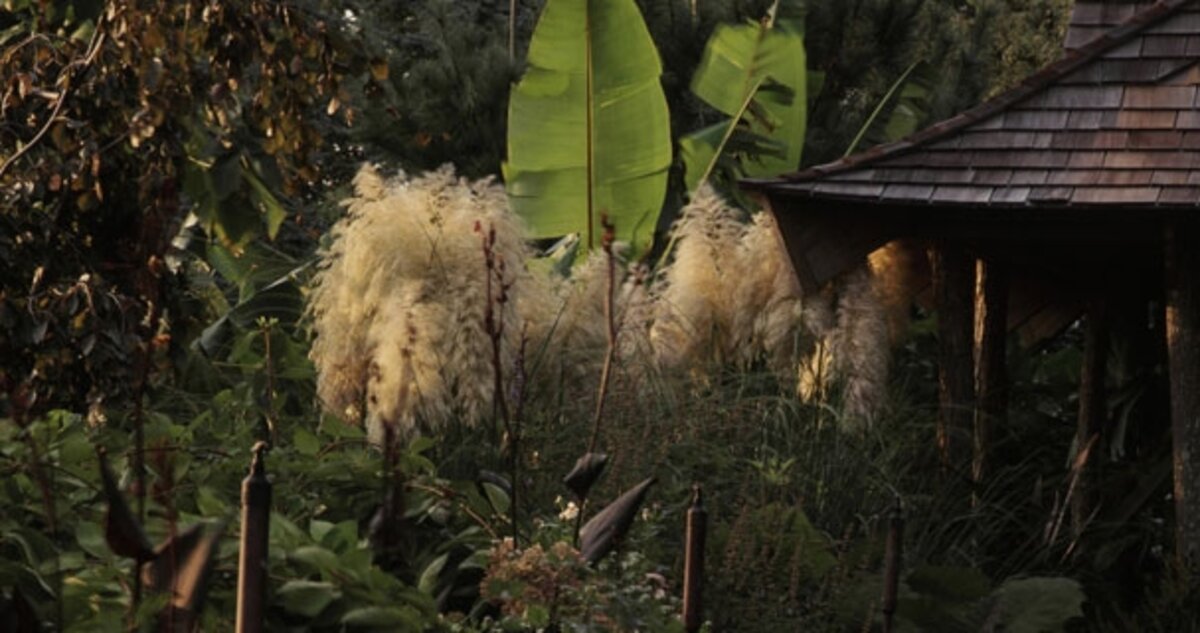Is this really New York or are we in the tropics?
Loading...
See that photo of the banana tree above? No, your eyes do not deceive you. Yes, it shows the east end of Long Island and, yes, the landscape includes a grove of banana trees – close to 100 of them, about 16 feet tall.
Close your eyes and you can almost feel the tropical breezes rustling the giant leaves.
And, yes, although this garden is in New York State, those are palm trees over there, their fronds gently clacking in the ocean breeze.
And, yes, there is Dennis Schrader, smiling for all the world like a man who has turned nature and climate on its collective head.
Mr. Schrader and Bill Smith run a wholesale nursery on their 17-acre farm, but about 2-1/2 acres have been crafted into gardens around the house, a landscape firmly in the throes of zonal denial.
“We’re a few blocks from the Long Island Sound and a couple thousand feet from Mattituck Inlet, so we’re surrounded by water,” Schrader says. “It’s a big help. There’s lots of reflected light, and the water moderates the temperature in fall. This is one of the last places on Long Island to get frost. But on the other hand, it takes a little longer to get warmer in the spring.”
Welcome to island living in the Northeast’s little banana belt.
“One block away is the town of Cutchogue, which is the sunniest place in New York,” Schrader says. “The state agriculture department rated it that – somebody official.”
But what is now a sweeping tapestry of subtropical beauty overflowing its series of garden rooms was a tangled mess when Schrader and Mr. Smith bought the 1840s farmhouse.
“This had been an abandoned farm for about seven years,” Schrader says. “Before that, it was in corn, and before that potatoes for 50 or 60 years. We had to deal with seven years’ growth of poison ivy, wild raspberries, wild roses, and ... saltbush, a native, which has a nice fall seed display, but nothing you’d want 17 acres of.”
The previous owners had “farmed right up to the back of the house,” he adds, “and when the poison ivy took over, it grew 6 feet, easy.”
Little by little, the two cleared the acreage around the house by hand – “which was quite a chore,” Schrader says wryly – and spent the next year rotating cover crops to improve the soil.
“Corn is such a heavy feeder, there was not much nutritional value left in the soil,” he explains.
So various kinds of cover crops were planted to restore the soil’s nutrition – vetch gave way to sorghum, then to winter rye, which was followed by yet another type of rye.
“We kept tilling them in, and it really boosted things,” he says. “We got a nice loam.”
Moving from populous Nassau County to the country, Schrader and Smith were excited to have so much space and began a huge vegetable garden that “was bigger than the plot of land I previously lived on,” Schrader says.
But the garden soon became more chore than pleasure, and the two often ended up giving the overbounteous results away.
And despite the fence, there were – inevitably on Long Island – deer.
One day a small herd infiltrated the garden, and when discovered, they calmly walked off – almost single file – but, unfortunately, wearing the fence much like a bridal veil as they receded into the distance.
“That was the end of the vegetable garden,” Schrader says. Instead, “we started putting in (ornamental) gardens.”
The landscaper/designer duo were no strangers to decorative plants. In their past lives, they often were called upon to pot up 150 containers of annuals around, say, an estate’s pool.
“And every year it had to be different,” Schrader says.
“So we did different themes: lush, tropical one year; Mediterranean-style the next; water gardens where we plugged up the holes in the pots and filled them with water and aquatics. One year we did all vegetables in pots; another year, fruit.”
Now this emphasis on tropicals is evident in the landscape they’ve created for themselves as well as in containers.
The thematic approach is divided by hedging – what he calls “barriers your eye would trip over” – with “garden rooms” defined by hornbeam and American beech trees and arctic willow and boxwood shrubs.
But it is another kind of room in the garden that is Schrader’s favorite – a tiki hut decorated in what he smilingly calls the “Asian-Adirondack style.”
“It’s the only place where I can sit and relax a couple hours on Sunday,” he says. “It has great breezes, great views. And it’s a great place to entertain.”
Ten tropical tips
Schrader, the author of “Hot Plants for Cool Climates: Gardening With Tropicals in Temperate Zones ” likes plants with a bold look that make a statement, especially texturally. “I don’t like a lot of fussy, flowery cottage-looking things,” he says.
Here are his three favorite tropical plants for the landscape:
1. Gingers – “especially the super-fragrant ones.”
2. All the elephant ears (Alocasia). “There’s a new one called Stingray that looks exactly like a stingray [fish] with a big round leaf and a tail.”
3. The Siam Ruby banana, with its “nice reddish leaf and yellow markings.”
In containers, he especially recommends:
1. South African rushes – “a real structural plant.”
2. “A lot of the succulents – like kalanchoe, that whole group of plants.”
3. Bromeliads – “I’ve been on a real bromeliad kick lately. There’s so much great breeding lately with great color.”
4. Vines that grow up and through taller plants such as sugar cane.
While researching his latest book, “Extraordinary Leaves” (Firefly), Schrader became especially enamored with the foliage of:
1. Black-leaved cotton.
2. Coleus – “Interest in coleus just does not fade out.”
3. Caladiums – “You know how in Holland a long time back the market in tulip bulbs went so crazy? That’s what’s going on now in Thailand. They’re getting some amazing, amazing leaves – every kind of color – almost black, even some yellow ones.”




